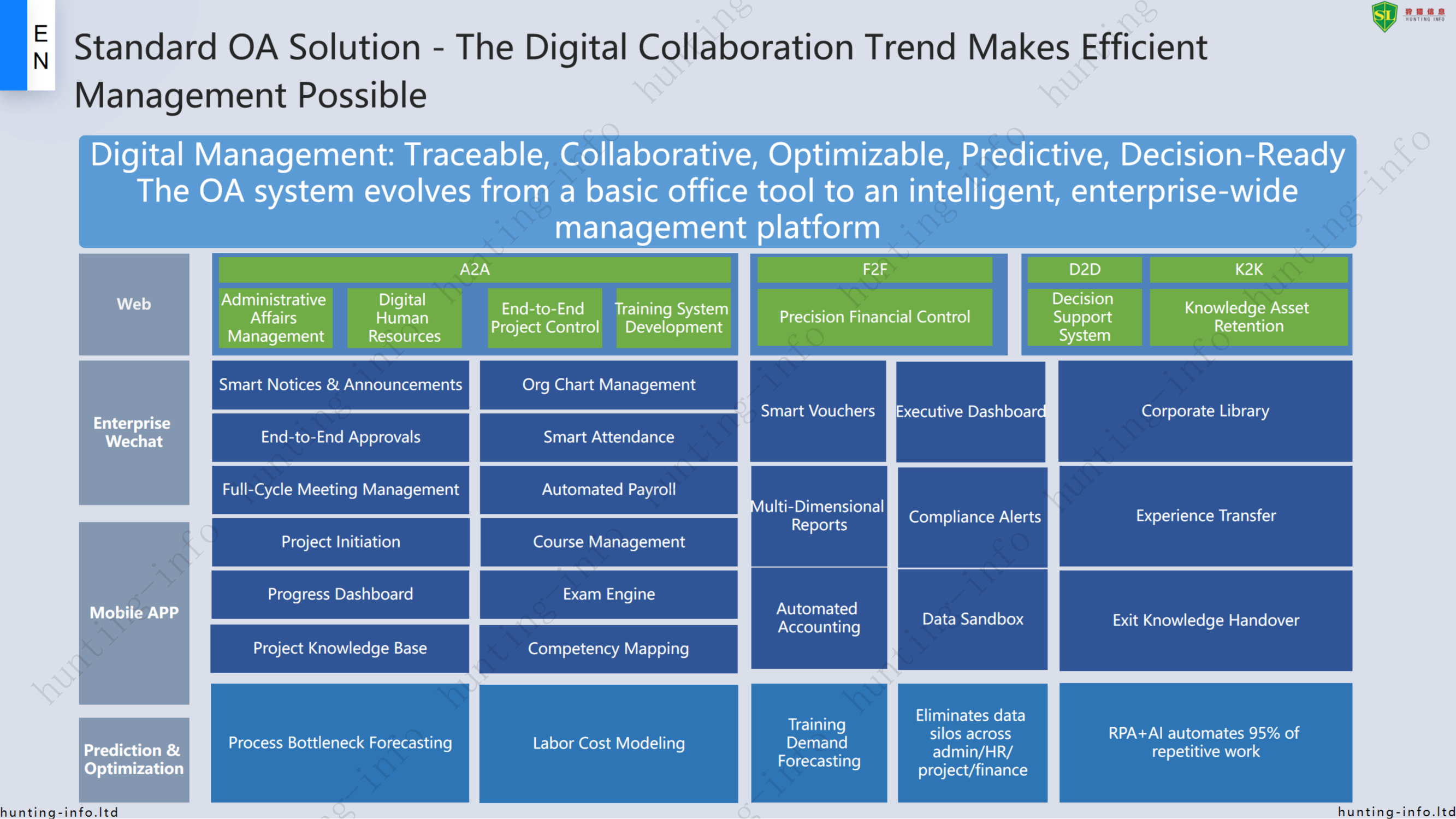Our intelligent OA system serves as the central engine for business efficiency, delivering three core values:
- Process Automation - Handles repetitive tasks like approvals/reimbursements, reducing human errors by 90%
- Cross-team Collaboration - Unifies IM/email/project tools for real-time enterprise-wide communication
- Mobile Workplace - Multi-device access accelerates response times by 60%

Pain Points of Traditional Office Models
- Manual workflows: Approvals rely on paper/offline communication, leading to redundant tasks.
- Over-reliance on individual experience: Inconsistent task allocation and follow-up with no standardization.
- Information loss: Files stored haphazardly, causing critical data gaps during personnel changes.
- Inefficient management: Decisions based on intuition rather than data, resulting in process inefficiencies.
Advantages of Intelligent OA Systems
- Automated workflows: Smart approval routing reduces manual intervention, boosting efficiency by 50%+.
- Standardized collaboration: Automated task assignment, reminders, and tracking to eliminate delays and oversights.
- Centralized knowledge management: Unified document storage with full traceability, enabling faster onboarding.
- Data-driven decision-making: Real-time dashboards identify bottlenecks for precise management adjustments.
Standard OA Solution – The Digital Collaboration Trend Makes Efficient Management Possible
Digital Management: Traceable, Collaborative, Optimizable, Predictive, Decision-Ready
The OA system evolves from a basic office tool to an intelligent, enterprise-wide management platform, covering five core modules: Administration, Human Resources, Project Management, Training, and Finance. The solution includes the following 8 key functions:

1. A2A – Administrative Affairs Management
(1) Smart Notices & Announcements: Real-time multi-platform sync with read status tracking
(2) End-to-End Approvals: E-signature/Mobile approval/Intelligent reminders
(3) Full-Cycle Meeting Management: Scheduling → Notification → Minutes → Execution
2. H2H – Digital Human Resources
(1) Org Chart Management: Visual role-based permission configuration
(2) Smart Attendance: Multi-mode clock-in/Anomaly auto-alerts
(3) Automated Payroll: Tax calculation/Encrypted payslip distribution
3. P2P – End-to-End Project Control
(1) Project Initiation: Online application/Multi-level approval/Resource pre-allocation
(2) Progress Dashboard: Gantt charts/Milestone alerts/Blockage tracking
(3) Project Knowledge Base: Version-controlled docs/Cross-team sharing
4. T2T – Training System Development
(1) Course Management: Live & recorded sessions/Credit system/Effectiveness evaluation
(2) Exam Engine: AI-generated tests/Anti-cheating/Auto-grading
(3) Competency Mapping: Training data linked to role proficiency models
5. F2F – Precision Financial Control
(1) Smart Vouchers: OCR recognition/Automatic journal entry
(2) Multi-Dimensional Reports: Cost center/Project/Department drill-down analysis
(3) Automated Accounting: Reconciliation/Period-end closing/Consolidated statements
6. D2D – Decision Support System
(1) Executive Dashboard: Process efficiency/Resource utilization/Cost breakdown visualization
(2) Compliance Alerts: Real-time flags for budget overruns/Contract expirations/Approval delays
(3) Data Sandbox: Custom analysis models/Scenario simulation
7. K2K – Knowledge Asset Retention
(1) Corporate Library: Tiered permissions/Watermarking/Smart search
(2) Experience Transfer: Process templates/Best practice cases
(3) Exit Knowledge Handover: Digital task transition checklists
8. Prediction & Optimization
(1) Process Bottleneck Forecasting: Approval duration/Rejection rate analysis
(2) Labor Cost Modeling: Headcount optimization/Compensation structure simulation
(3) Training Demand Forecasting: Skill gap/Course popularity analytics